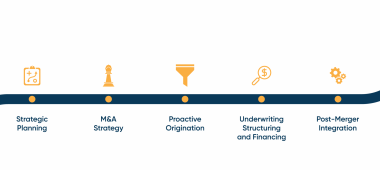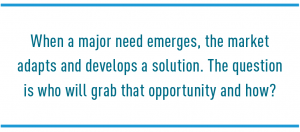This article was originally published in the Journal of Corporate Renewal (JCR), the official publication of the Turnaround Management Association (TMA).
With each passing day, turnaround advisors, bankruptcy attorneys, and other supporting professionals answer the call as more and more businesses fight for their lives. Some of these businesses will implode from the pressures of the coronavirus crisis, while others will nimbly pivot and thrive with new opportunities. But there is no doubt that the turnaround industry serving them will soon have—or may already have—more work than it can handle.
While it’s easy to hope COVID-19 passes quickly and everyone can return to their normal work routines, the medical consensus is that the virus will be an ongoing fact of life for the near to midterm, with significant implications on the turnaround industry and how it can safely and effectively assist its clients.
Tsunami of Need
The economic impact of lockdowns combined with the collapse in oil pricing has created the perfect recipe for mass simultaneous distress on an order of magnitude the turnaround industry has never seen. While the recent spike in bankruptcies is likely associated with businesses that were already experiencing challenges pre-COVID, the real surge is yet to come, as the pandemic’s assault on the economy will begin to be fully realized after Q2 2020 financials are released. As one bankruptcy attorney said, “The tsunami is going to happen in the coming months and it’s going to be ongoing.”1
All of this presents a huge imbalance of supply and demand. The largest advisory firms will be drowning in work, and anecdotally, many of their partners are indicating that they are moving upmarket. That will leave a huge vacuum in the midmarket for smaller, cost-effective advisors to address. Clients need help now.
To be sure, recessionary times have always been the most profitable periods for turnaround and restructuring professionals, but this unprecedented surge in demand will greatly exceed prior spikes during the Great Recession and other downturns. The opportunity exists
for explosive growth, but the associated challenges can be significant. As every turnaround professional knows, the stress of too much growth can also cripple businesses.
It’s imperative that firms prepare to scale up efficiently while ensuring consistent quality and the safety of their employees. Hypergrowth comes with its set of challenges, including maintaining a consistent work culture, standardizing work products and quality, and ensuring effective communication and coordination, a challenge compounded by new employees starting remotely. What’s more, this crisis brings with it a new reality: Most current advisory business models simply will not work in a COVID-19 world.
Travel Constraints
While many clients and professionals have successfully embraced some aspects of remote work, this is also an industry where some in-person interaction with clients is essential, particularly in the middle market, where companies often don’t have all the systems and processes in place that larger businesses have. Most turnaround professionals are embracing new tools for working remotely, which can help minimize exposure to COVID-19 and improve efficiency, but there’s just no way that a successful operational turnaround or liquidation is going to occur completely remotely.
Business travel, which fuels the turnaround industry, will likely be greatly diminished. Advisors won’t be able to easily hop on a plane to meet with clients because of erratic flight schedules driven by reductions in domestic flights on some routes by up to 90% and the significant friction in mobility as dozens of states implement travel restrictions. For example, Florida Executive Order 20-139 requires all travelers from the New York Tri-State area to self-quarantine for 14 days, while those same states (and likely others in the coming weeks) require the same for any travelers arriving from states with high infection rates—criteria met by eight states, including Florida, as this is written. What would once have been a day trip to Orlando from New York should take nearly a month to comply with those mandates.
As the world sets into its new normal, it is going to become more balkanized and decentralized, at least until a vaccine is widely available and perhaps even beyond that time. This means firms will want to have either distributed teams within about a six-hour driving radius of their clients or talent willing to relocate for tours of duty lasting months at a time. Rather than speed-dialing their go-to national firm relationships, clients will likely need specific state-level solutions. While there should be little issue accommodating demand near major turnaround markets such as New York, Chicago, and Houston, the challenge may be much harder for regions that are more remote from such markets.
But that doesn’t mean throwing up offices all over the place. Given the speed with which things are unfolding, hiring and opening up new satellite locations could not occur fast enough anyway.
Creative Solutions
When a major need emerges, the market adapts and develops a solution. The question is who will grab that opportunity and how?
Since the Great Recession, the ranks of turnaround professionals have been thinned by a decade of economic growth and much talent aging out of the workforce. Bankruptcy attorneys offer one example. The Wall Street Journal reports that one out of every three currently practicing lawyers graduated from law school before 1990.2 Finding talent to handle additional work will be harder this time around. Many firms are already repurposing their generalist corporate finance consultants to work with distress.
For a creative solution to scaling up, a firm should think outside of its walls. They should consider subcontracting on-the-ground roles to other firms or becoming that partner for larger firms based elsewhere. There will be opportunities to partner like never before.
Firms should be prepared to divide tasks that can be done remotely, which can be handled by internal teams, from those that must be done on-site, which could be completed by third-party partners. Firms should develop strong networks of subcontractor or referral relationships that can seamlessly cover the entire United States. While most turnaround professionals have some relationships with colleagues in other parts of the nation, there likely will be gaps. Identifying and selecting potential partners and backup relationships takes time and should begin as soon as possible. Experience indicates the following factors should be considered when selecting partners:
- Capacity and availability
- Willingness to work at client sites
- Capabilities of team
- Industry experience
- Functional expertise
- Compatibility with culture and values
- Economics and preferred working terms
Before pursuing or accepting new engagements, it’s also highly recommended to quickly validate the bandwidth of the specific expertise needed, as availability can change quickly, especially for smaller firms.
Turnaround advisory firms that want to meet the challenge and scale up will form strategic partnerships, train quickly, and realize that having a finger on everything is not realistic. They will have to figure out all of this on the fly—while spending more time on the ground. Clients’ livelihoods are depending on it.












